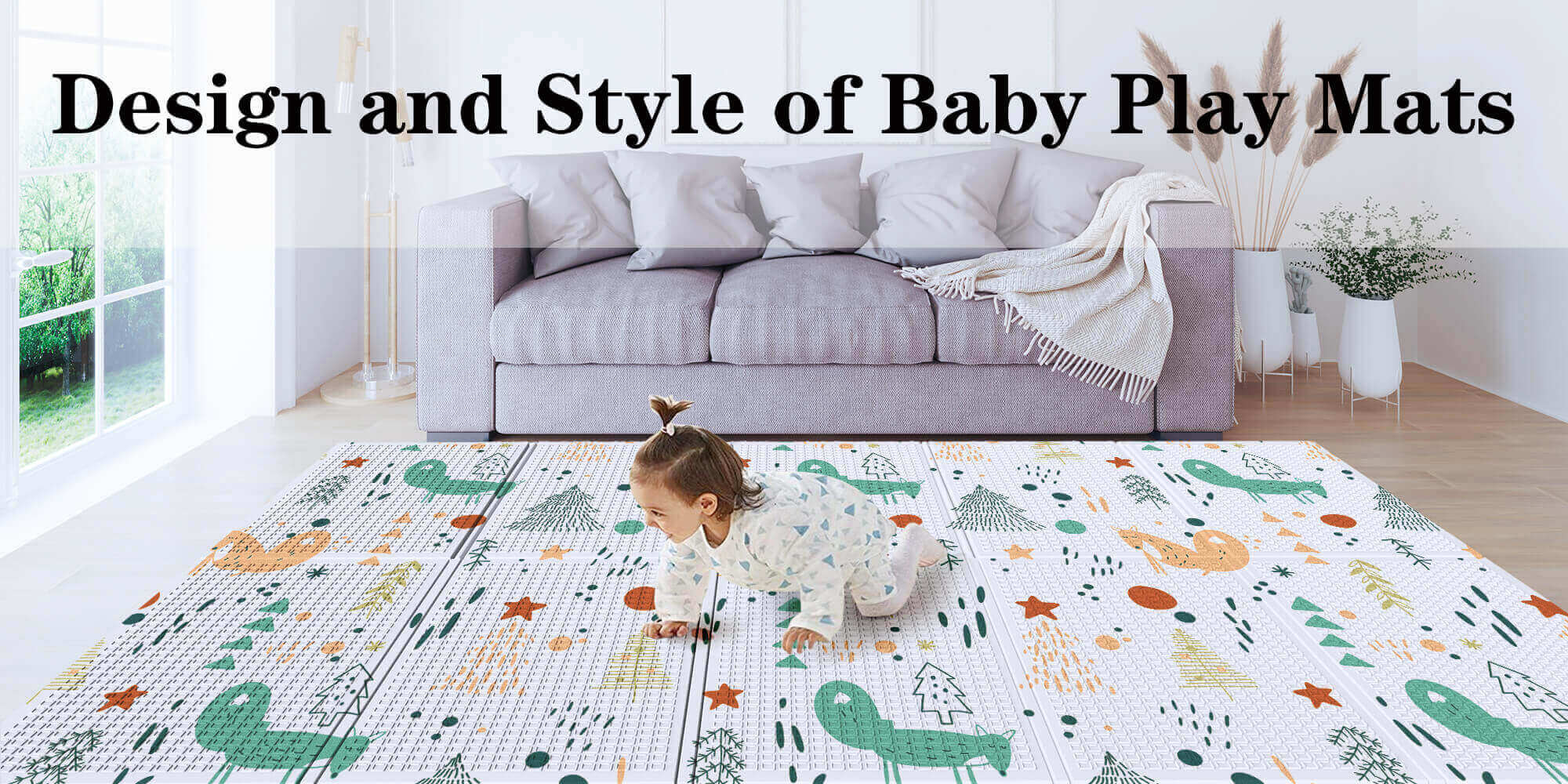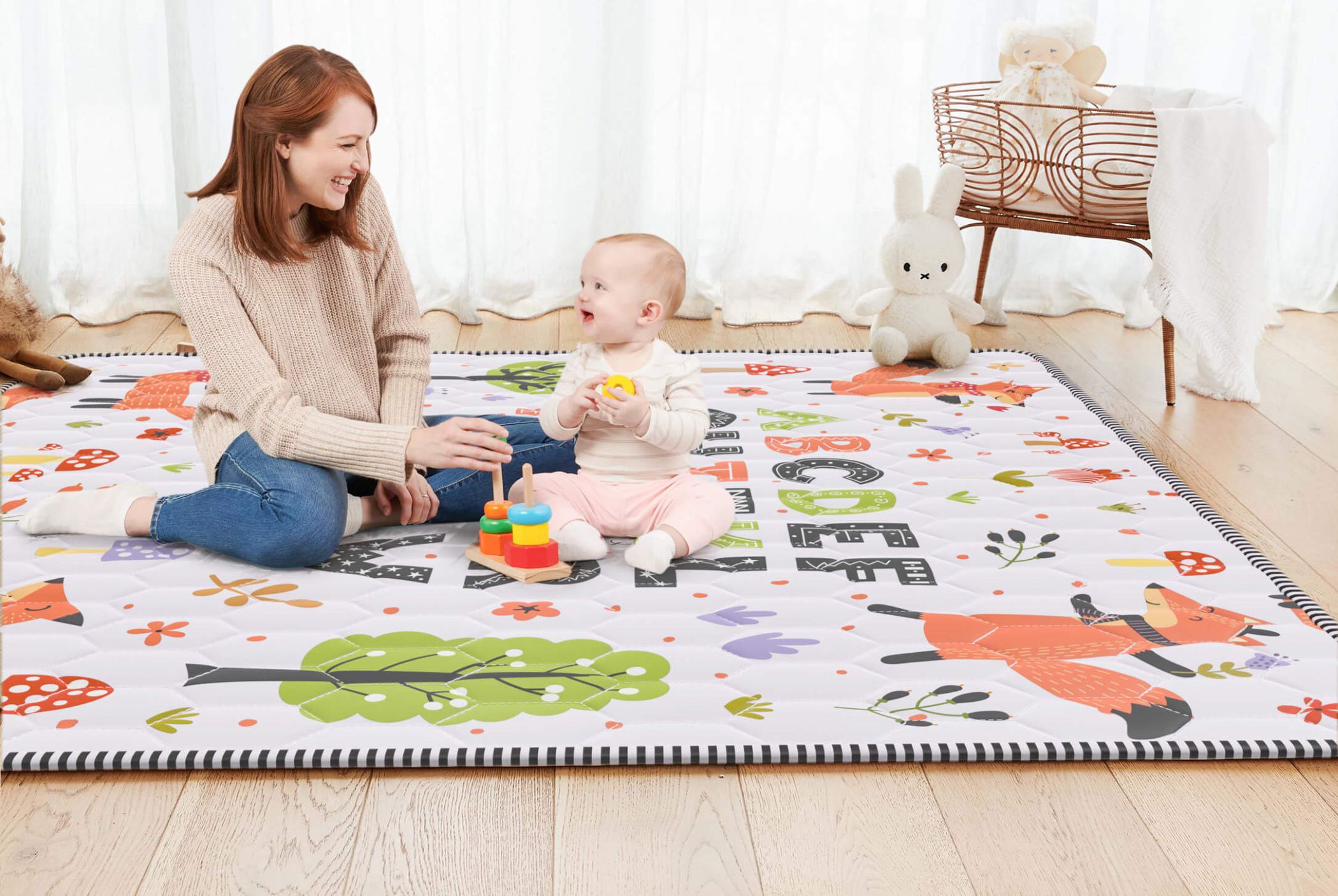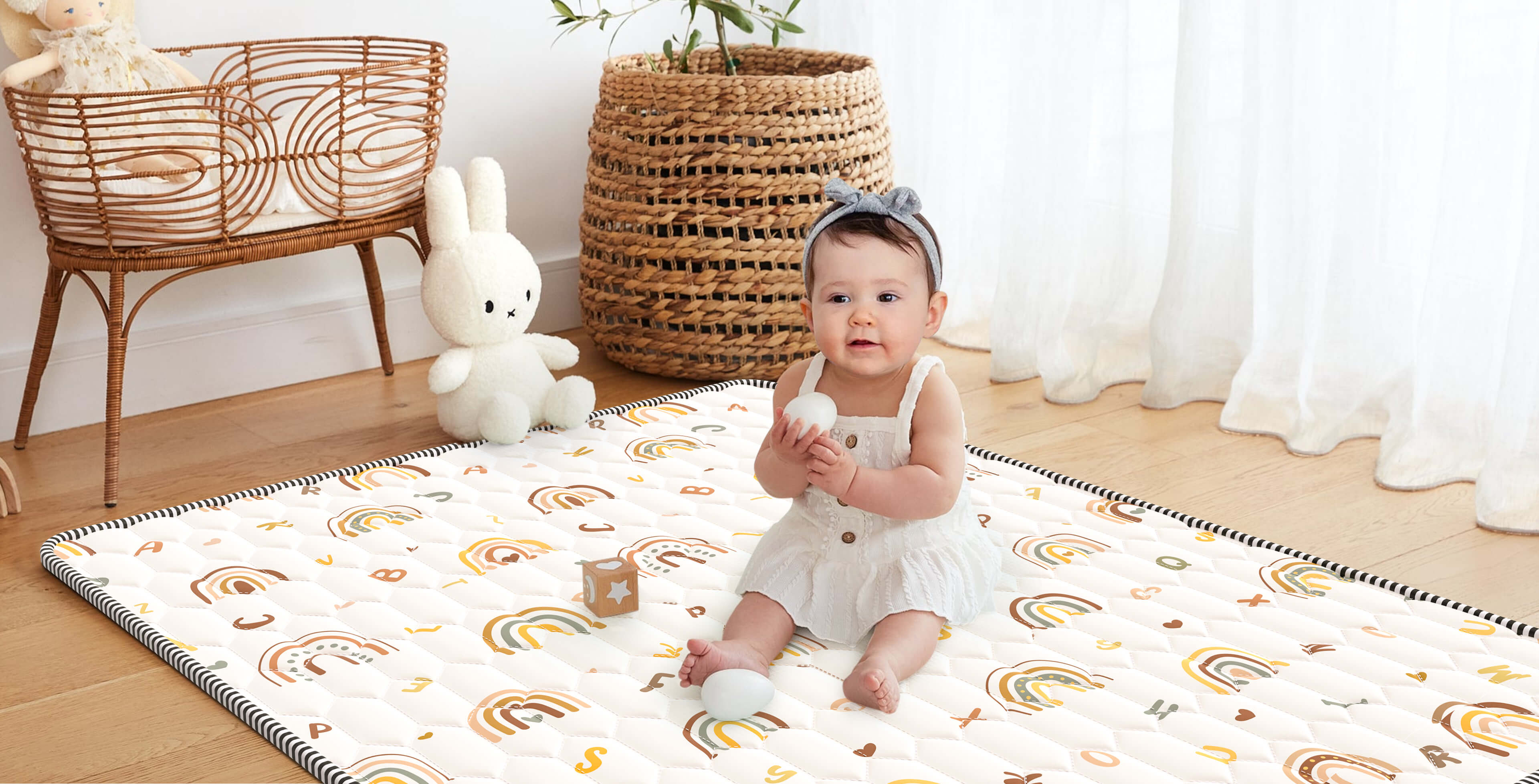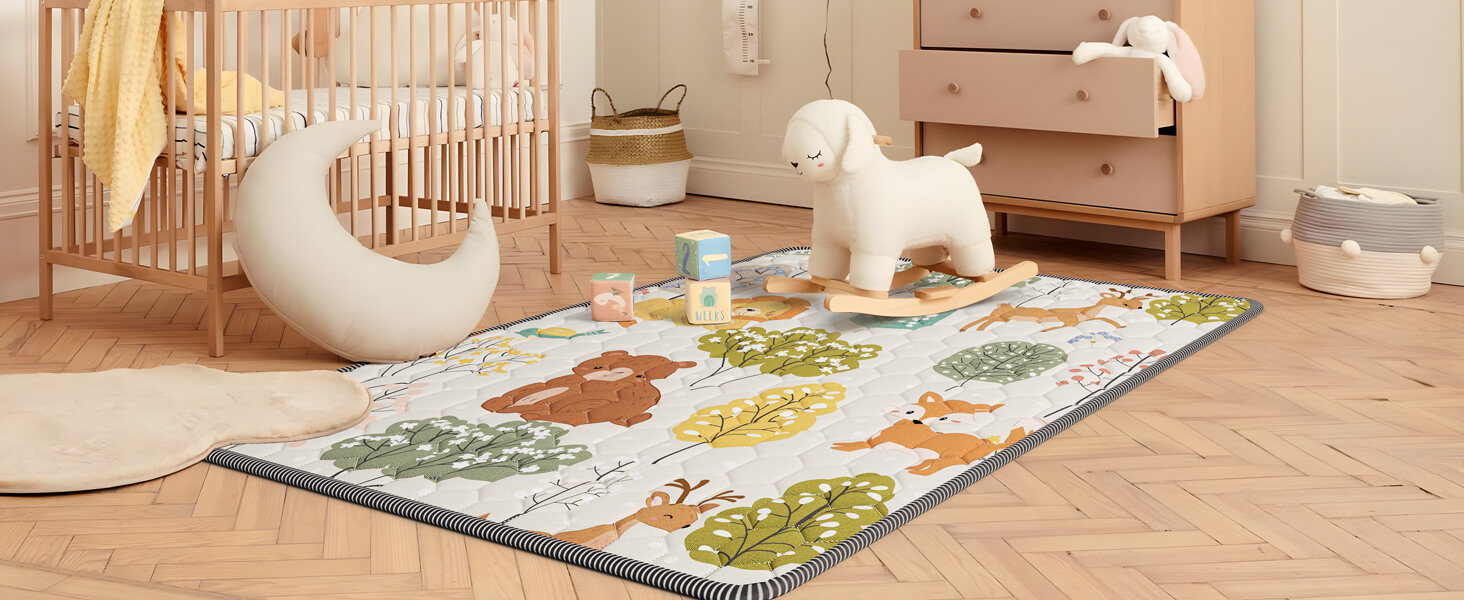
- Home
- Baby Play Mats
- Baby Play Mat Materials: A Comprehensive Guide for Parents
Baby Play Mat Materials: A Comprehensive Guide for Parents

When it comes to your baby’s safety, comfort, and developmental growth, selecting the right baby play mat is crucial. These mats offer a safe and soft space for babies to play, crawl, and explore, but not all play mats are created equal. One of the most critical factors to consider is the material from which the play mat is made. The material influences everything from comfort to durability, safety, and even ease of cleaning. In this guide, we’ll explore different baby play mat materials, their benefits, and potential drawbacks, so you can make an informed decision that best suits your baby’s needs and your household’s requirements.
1. EVA Foam Play Mats
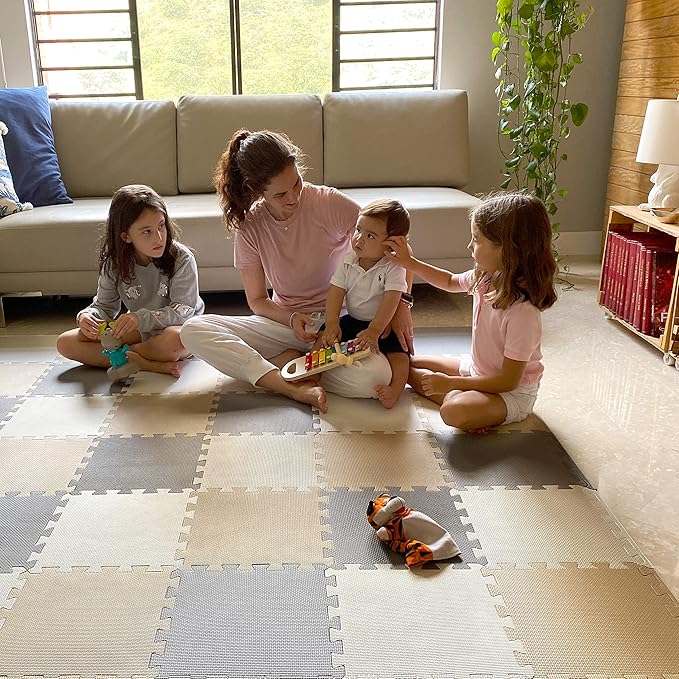
What Is EVA Foam?
EVA (Ethylene Vinyl Acetate) foam is a soft and rubber-like material often used in baby play mats. It is known for its cushiony texture and shock-absorbent properties, making it a favorite among parents looking for mats that provide ample protection during falls.
Benefits of EVA Foam Mats
Cushioning: EVA foam mats provide excellent padding, which is essential for babies learning to crawl or sit up.
Durability: These mats are known for being long-lasting, retaining their shape even after extensive use.
Waterproof: One of the standout features of EVA foam is that it is waterproof, making the mat easy to clean from spills or diaper leaks.
Non-Toxic: Many manufacturers claim that EVA foam is non-toxic, BPA-free, and safe for babies. However, it’s important to choose a mat that has been independently tested for harmful chemicals like formamide, a common concern with foam products.
Drawbacks of EVA Foam Mats
Chemical Sensitivities: Despite being marketed as non-toxic, some EVA foam mats may release chemical odors when first opened. This can be a concern for parents sensitive to chemical off-gassing.
Firmness: While cushiony, EVA foam mats can sometimes feel too firm for delicate newborns or babies needing extra support.
Ideal For:
Parents looking for an easy-to-clean, affordable, and shock-absorbent mat, suitable for toddlers and active babies.
2. PVC Play Mats
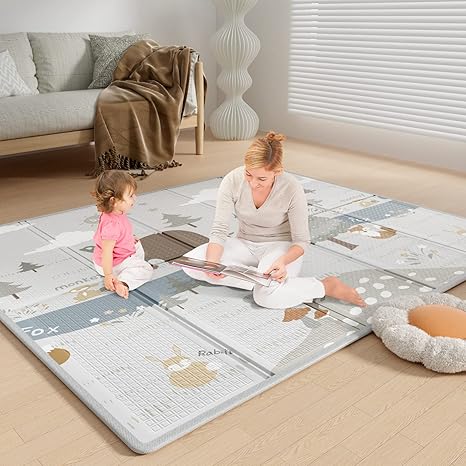
What Is PVC?
Polyvinyl Chloride (PVC) is a synthetic plastic polymer used in many household products. PVC play mats are often highly durable and water-resistant, making them another popular choice for baby play areas.
Benefits of PVC Mats
Durability: PVC mats are resistant to wear and tear, making them ideal for high-traffic areas in your home.
Waterproof: Like EVA foam, PVC mats are waterproof and can be wiped clean easily.
Variety: These mats come in various colors, designs, and thicknesses, allowing parents to choose mats that complement their home decor or fit their baby’s specific needs.
Drawbacks of PVC Mats
Chemical Concerns: PVC is often criticized for containing phthalates, chemicals used to make the plastic flexible but known to be harmful in certain concentrations. It’s essential to ensure the mat you select is free from harmful chemicals such as phthalates and lead.
Environmental Impact: PVC is not the most environmentally friendly material. The production process can lead to harmful emissions, and it is not easily recyclable.
Ideal For:
Parents who prioritize durability and waterproof properties but are cautious about chemical composition. Always check for certifications indicating the mat is free from harmful additives.
3. Cotton Baby Play Mats
What Is Cotton?
Cotton is a natural fiber well known for its softness and breathability. Cotton baby play mats are typically quilted and padded, offering a softer and more organic alternative to synthetic materials.
Benefits of Cotton Mats
Softness: Cotton mats are exceptionally soft, making them perfect for newborns and babies who need extra support for their fragile bodies.
Natural and Non-Toxic: As a natural material, cotton is a safer alternative to synthetic options, especially if the cotton is organic and free from chemical treatments.
Breathability: Cotton is naturally breathable, which can help regulate a baby’s body temperature, especially during warmer months.
Machine-Washable: Many cotton play mats are machine-washable, which makes them convenient for cleaning after messy playtimes.
Drawbacks of Cotton Mats
Absorbent: Cotton mats are not waterproof, so they can absorb liquids easily, leading to potential staining and a longer drying time after cleaning.
Less Durability: Cotton, especially when not reinforced with additional padding or backing, may not hold up as well over time compared to synthetic materials like foam or PVC.
Ideal For:
Parents who prefer natural, eco-friendly materials and want a soft, breathable option for newborns and younger babies.
4. Polyester Baby Play Mats
What Is Polyester?
Polyester is a type of synthetic fiber made from petroleum products. It is widely used in clothing, upholstery, and baby products, including play mats, because of its durability and affordability.
Benefits of Polyester Mats
Durability: Polyester is a very durable material, making it a great option for parents who need a mat that can withstand heavy use.
Water-Resistant: Polyester mats typically resist water better than cotton, although they are not entirely waterproof. They can be spot cleaned easily.
Affordability: Polyester mats tend to be more affordable than natural fiber options, offering a budget-friendly solution for parents.
Variety: Polyester mats come in a variety of textures and designs, from plush to flat surfaces, offering plenty of options for different preferences.
Drawbacks of Polyester Mats
Less Breathable: Polyester is less breathable than cotton, meaning it can feel warmer, especially if your baby spends extended periods on the mat.
Potential for Chemicals: Polyester is treated with chemicals during manufacturing, so it’s important to choose mats that have been tested for safety to avoid exposure to potentially harmful substances.
Ideal For:
Parents looking for a durable, budget-friendly option that offers water resistance and comes in various textures and patterns.
5. Rubber Play Mats
What Is Rubber?
Natural rubber play mats are made from the sap of rubber trees. They are praised for their eco-friendly production and their soft yet durable texture. Rubber mats offer excellent cushioning and protection for babies, making them a popular choice for parents focused on safety and sustainability.
Benefits of Rubber Mats
Non-Toxic: Natural rubber is an eco-friendly, non-toxic option. It’s free from harmful chemicals like BPA and phthalates, making it safe for babies.
Cushioning: Rubber mats provide excellent shock absorption, perfect for protecting babies from falls during playtime.
Anti-Slip Surface: The natural grip of rubber provides a non-slip surface, making these mats safer for active babies who are learning to walk.
Eco-Friendly: Rubber is a renewable resource and biodegradable, making it a great option for environmentally conscious parents.
Drawbacks of Rubber Mats
Price: Rubber mats tend to be more expensive than other types of mats, largely due to their eco-friendly production and high-quality material.
Maintenance: While durable, rubber mats can be difficult to clean and may retain odors if not maintained properly.
Ideal For:
Eco-conscious parents who prioritize safety, cushioning, and non-toxic materials in their baby’s play environment.
6. Memory Foam Play Mats
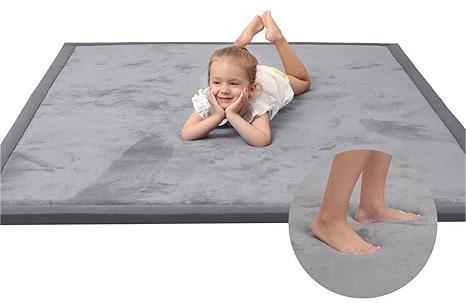
What Is Memory Foam?
Memory foam is a type of polyurethane foam that molds to the shape of your baby’s body, providing personalized comfort and support. These mats are often thicker and provide greater cushioning than standard EVA foam or polyester mats.
Benefits of Memory Foam Mats
Comfort: Memory foam mats offer a plush, cushiony surface that contours to your baby’s body, making them exceptionally comfortable.
Support: This material provides excellent support for babies who are crawling or learning to walk, reducing the impact on joints.
Durability: Memory foam mats tend to be long-lasting, holding up well under repeated use without losing their shape.
Drawbacks of Memory Foam Mats
Not Water-Resistant: Memory foam is not water-resistant, and liquids can seep into the material if spills are not cleaned up quickly.
Heat Retention: Memory foam can retain heat, which may make the mat less comfortable in warmer climates or during summer months.
Chemical Off-Gassing: Like other types of foam, memory foam may emit an odor when first unwrapped due to chemical off-gassing. Choosing a high-quality, low-VOC (volatile organic compounds) product can minimize this risk.
Ideal For:
Parents who prioritize comfort and support for their baby and are willing to invest in a higher-end play mat with exceptional cushioning properties.
7. Cork Baby Play Mats
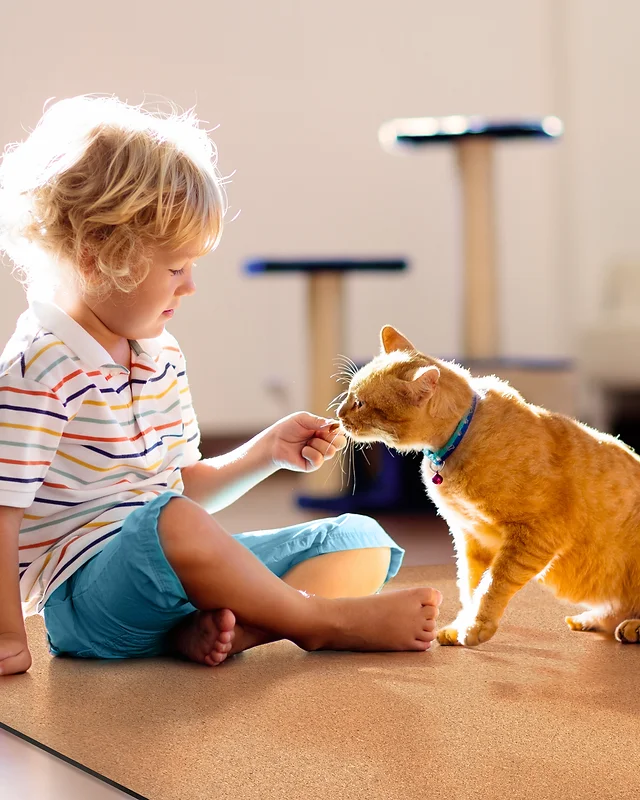
What Is Cork?
Cork play mats are made from the bark of cork oak trees, making them an all-natural and sustainable material. Cork is becoming increasingly popular in the baby product market due to its eco-friendly qualities and unique texture.
Benefits of Cork Mats
Eco-Friendly: Cork is a sustainable and renewable resource, making it one of the most environmentally friendly play mat materials.
Non-Toxic: Free from harmful chemicals, cork is naturally hypoallergenic, antibacterial, and antimicrobial, making it safe for sensitive babies.
Soft and Firm: Cork offers a unique balance between softness and firmness, providing a safe and comfortable surface for babies to play on.
Slip-Resistant: Cork is naturally slip-resistant, offering stability for babies learning to crawl or walk.
Drawbacks of Cork Mats
Price: Cork mats tend to be more expensive due to their sustainable production methods.
Limited Design Options: Cork mats typically have a natural, earthy aesthetic, which may not appeal to all parents.
Ideal For:
Parents who are looking for an all-natural, non-toxic play mat that provides both comfort and safety, while also being eco-friendly.
8. Recycled Play Mats
What Are Recycled Mats?
Recycled play mats are made from repurposed materials such as recycled plastic, rubber, or other synthetic fibers. These mats offer a sustainable option for parents who want to reduce their environmental footprint.
Benefits of Recycled Mats
Sustainability: By using recycled materials, these mats help reduce waste and lower the environmental impact of production.
Durability: Recycled materials are often just as durable as their non-recycled counterparts, providing long-lasting play surfaces.
Variety: Recycled mats can come in a variety of materials, including rubber and plastics, giving parents multiple options in terms of texture and design.
Drawbacks of Recycled Mats
Chemical Concerns: Depending on the source of the recycled materials, some mats may contain residual chemicals or contaminants, making it essential to verify the safety and testing standards of the product.
Higher Cost: While recycled materials help the environment, they can sometimes be more expensive than virgin plastic or foam options.
Ideal For:
Eco-conscious parents who want a durable, sustainable mat option and are willing to invest in a higher-quality product.
Conclusion: Choosing the Best Baby Play Mat Material for Your Family
Selecting the right baby play mat material depends on various factors, including your baby’s developmental needs, your household environment, and your personal preferences for sustainability, safety, and convenience. Whether you prioritize the eco-friendliness of cork or the practicality of EVA foam, understanding the pros and cons of each material will help you make an informed decision that ensures both comfort and safety for your baby.
When shopping, always look for certifications that guarantee the mat is free from harmful chemicals, and opt for materials that suit your family’s lifestyle and your baby’s stage of development.


